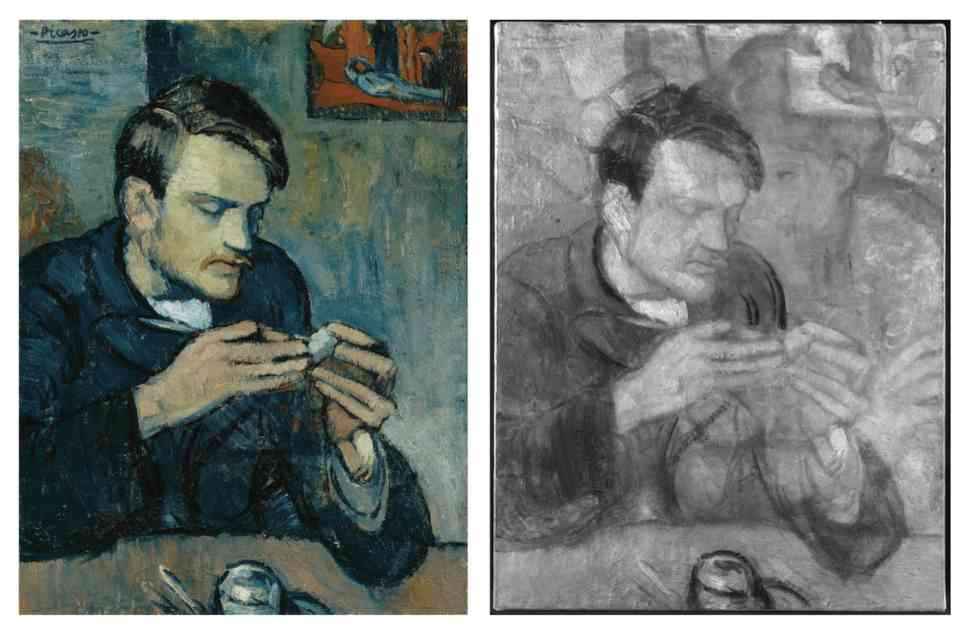A Hidden Gem Unveiled: Uncovering the Mystery Beneath Picasso’s Blue Period Masterpiece
In a surprising turn of events, conservators at the prestigious Courtauld Institute of Art in London have unearthed a hidden gem beneath one of Pablo Picasso’s iconic Blue Period portraits. The revelation came during the examination of the Portrait of Mateu Fernández de Soto (1901), a poignant depiction of a Spanish sculptor and close companion of the artist during his formative years.
Picasso’s Blue Period is widely regarded as a pivotal moment in the painter’s early career, marked by a departure from traditional techniques in favor of bold brushstrokes and a haunting blue-green color palette. The emotional depth and introspection evident in his Blue Period works have long captivated art enthusiasts and scholars alike, making this recent discovery all the more remarkable.
Uncovering the Mystery Woman
The Portrait of Mateu Fernández de Soto holds a special place in art history, not only for its age and significance but also for the narrative it conveys. The painting pays tribute to the eponymous sculptor, whose tragic demise cast a shadow over Picasso’s artistic journey. However, recent analyses conducted by the Courtauld Institute have shed light on a hidden figure lurking beneath the surface of the canvas – a mystery woman whose presence challenges the conventional narrative of the artwork.
According to experts at the institute, the enigmatic woman was likely painted prior to de Soto and exudes a sense of sophistication characteristic of Parisian society at the time. Her distinctive chignon hairstyle and resemblance to other contemporary portraits by Picasso hint at a deeper connection to the artist’s inner circle. The painting’s multiple revisions and potential departure from the Impressionistic style preceding the Blue Period further emphasize the complexity of Picasso’s creative process.
Delving into the Identity
While the true identity of the mystery woman remains elusive, the Courtauld’s findings have sparked speculation about her role in Picasso’s life and art. Was she a model, a confidante, or perhaps a fleeting muse captured in a moment of contemplation? The institute’s statement reflects the ongoing intrigue surrounding this enigmatic figure, suggesting that further research and analysis may yield valuable insights into her significance within the larger context of Picasso’s oeuvre.
Barnaby Wright, deputy head of the gallery, expressed astonishment at the discovery, noting the transformative nature of Picasso’s artistic vision and the subtle nuances that define his body of work. The interplay between visible and hidden layers in the Portrait of Mateu Fernández de Soto exemplifies Picasso’s ability to transcend traditional boundaries and redefine the boundaries of artistic expression.
As art historians and enthusiasts ponder the implications of this newfound revelation, one thing remains certain: Picasso’s legacy as a masterful storyteller and stylistic innovator continues to captivate audiences worldwide. The legacy of the Blue Period lives on, enriched by the discovery of a hidden masterpiece that speaks to the enduring power of art to surprise, inspire, and challenge our perceptions of the world.
The story of the mystery woman beneath Picasso’s brushstrokes serves as a poignant reminder of the complexities that define artistic creation and the enduring allure of uncovering hidden truths within the layers of a masterpiece. With each stroke of the brush, Picasso invites us to delve deeper into the mysteries of human emotion, connection, and creativity, leaving us with a profound sense of wonder and appreciation for the transformative power of art.












